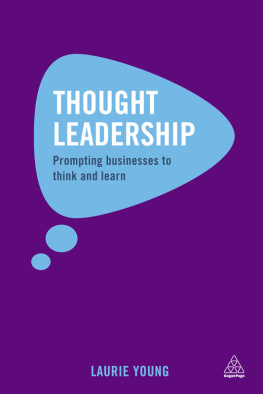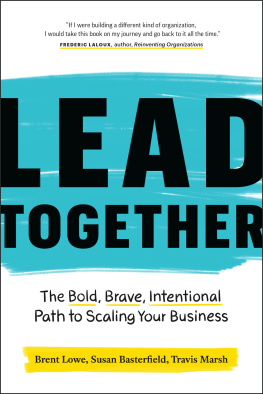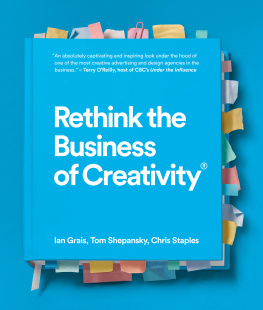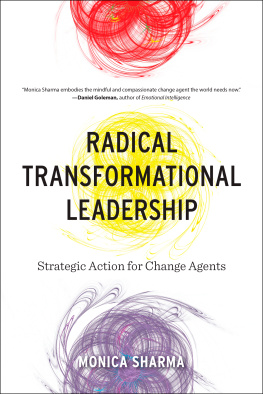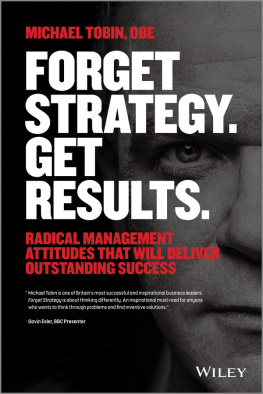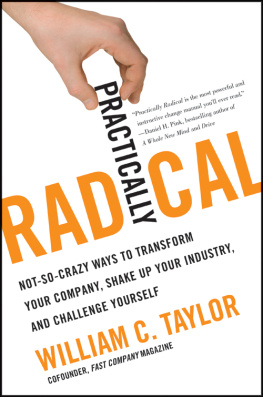L UCILLE G. T AYLOR
Introduction
A Game Plan for Game Changers
Problems cannot be solved at the same level of awareness that created them.
A LBERT E INSTEIN
If all you ever do is all youve ever done, then all youll ever get is all you ever got.
U NKNOWN T EXAS GENIUS
T HIS BOOK IS MEANT AS a guide for leaders in all walks of life who aspire to fix whats wrong with their organizations, to launch new initiatives with the best chance to succeed, and to rethink the logic of leadership itself as they work to rally their colleagues around an agenda for renewal. In other words, it is a manifesto for change and a manual for achieving itat a moment when change is the name of the game.
Full disclosure: A few years ago, when I first had the idea for Practically Radical, I had no inkling that America and the global economy were about to experience the worst dislocation since the Great Depression. And, truth be told, my mind-set in the early stages of this work, as stock markets slid and panic spread, was a self-centered mix of doubt and despair: How could I develop a game plan for game changers when everything was changing right before my eyesand in the wrong direction? How could I provide a set of insights and answers to help leaders transform their organizations when many of the economys leading organizations seemed to be on the brink of disasterand almost everything about leadership seemed to be open to question? How could I produce a work of energy and optimism when the spirit of the times was marked by fear, confusion, and division?
Then something eye-opening happened. I put aside my anxieties, set aside the grim headlines, and immersed myself in the struggles and triumphs of more than twenty-five organizations that are achieving dramatic results under some of the most trying conditions imaginable. Like most business thinkers, I read widely about the ever-changing dynamics of competition, work, and success: media accounts, scholarly articles, books, blogs, business-school cases. But the way I truly change my mind about business and organizational life is to see it for myself, up close and personal: to spend time with executives and frontline employees; walk the halls of their companies and factories; visit labs, warehouses, and stores; sit in on closed-door meetings; and hang out in training sessions. I learn the most when I encounter organizations whose strategy, culture, and day-to-day ways of working are the least like what passes for established thinking and conventional wisdom.
The more places I visited, and the closer I looked, the more convinced I became that turbulent times were precisely the right time to explore the hard work of making big change. I was privy to the strategies and tactics of a diverse collection of business innovators in a wide variety of fields: a high-profile Internet company that reinvented customer service for the digital age and invented an iconic brand in the process; a ninety-five-year-old hospital company, based in one of Americas most distressed cities, that has redesigned how a hospital works and what patients experience; the irrepressible billionaire who rescued the Swiss watch industry from near oblivion and transformed it into a global juggernaut; an upstart Brazilian retailer that figured out how to deliver rich shopping experiences to the countrys poorest shoppers and used its unique business model to hold its own against bigger rivals; a health-care company that recovered from near bankruptcy to thrive in a punishing field by unleashing an energetic and highly engaged workforce whose enthusiasm has to be seen to be believed.
I also made it a point to search beyond the traditional boundaries of business, to explore the hard work of making big change in areas where organizations play for high stakes, but where success is not defined by profit and loss. So I studied the strategies and tactics of a diverse collection of governmental, social, even cultural innovators in a wide variety of fields: the leader of one of the worlds most famous crime-fighting organizations, who has visited 125 countries in a crusade to transform how police respond to the most dangerous threats of the twenty-first century; the chief of one of the oldest police departments in the United States, who has remade a force that was once notorious for corruption and cronyism into a model of excellence and innovation; a world-class chamber orchestra that dazzles audiences around the world with its daring and precise live performances, despite the fact that it plays without the ultimate symbol of leadership in the classical-music world, the all-powerful conductor; the CEO of one of the most iconic and ubiquitous membership organizations in the United States, who has led a truly all-American case study in how to make a nearly one-hundred-year-old brand meaningful and relevant again.
These innovators were not paralyzed by the degree of difficulty associated with their agenda for renewal. In fact, they were energized by it. They were making big things happen in new waysunleashing improvements and driving transformations that will shape the fortunes of their organizations and the future of their fields for years to come. They were mastering a set of challenges that define the work of leaders in every fieldchallenges that the global economic crisis and its aftermath make more urgent than ever.
Paul Romer, the influential economist, is celebrated within the profession for his vital (albeit highly technical) contributions to our understanding of the relationship between new ideas, technological change, and growth. To us civilians, though, he may be best known for a passing quip that he made to New York Times columnist Thomas L. Friedman, a one-liner that has become the mantra of the moment from the White House to Silicon Valley: A crisis, Romer famously said, is a terrible thing to waste.
We are all struggling to make sense of the fallout from a once-in-a-lifetime crisis that promises to shape the economy and the business culture for years to come, to learn lessons that will guide us as we recover and rebuild. My worry is that too many leaders will learn the wrong lessons, that they will become conservative and risk averse, that they will resist deep-seated change rather than embrace it as the only way to emerge from the depths of their (and our) despair. That would be a huge mistakeand a terrible way to let a crisis go to waste.
In Reset, a meltdown-inspired treatise that argues for a sweeping reevaluation of American politics, culture, and society, novelist and radio host Kurt Andersen offers a reform agenda for business as well. It is urgent, he says, for executives to question their priorities and retool their strategies. At the same time, We must not start behaving now like overcautious, unambitious scaredy-cats, he warns. We cannot just hunker down, cross our fingers, hysterically pinch our pennies, wait for the crisis to pass, and expect to go back to business as usual.... This is the end of the world as weve known it. But it isnt the end of the world. It is, in fact, the moment for businesspeople to think different and think big.
I like how Andersen thinks. To be sure, at some level, corporate conservatismcut costs first, worry about the costs of those cuts lateris a natural reaction to decades of creativity run amok. Who are the geniuses who invented subprime loans and collateralized debt obligations, and cant we exile them to Elba for the next ten years? (Seems fair; Napoleon stayed for only three hundred days.) Werent we all better off before the creation of the vast worldwide market in derivatives, the impossible-to-understand financial contracts that were at the root of so much of what went wrong in the capital markets? Shouldnt we concede, once and for all, that our fascination with disruptive technologies and breakthrough business models has done more harm than good?

![Lester Loren Practically radical: [not-so-crazy ways to transform your company, shake up your industry, and challenge yourself]](/uploads/posts/book/214607/thumbs/lester-loren-practically-radical-not-so-crazy.jpg)


